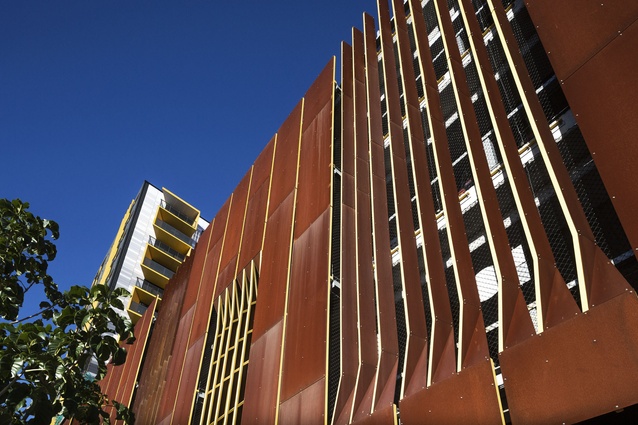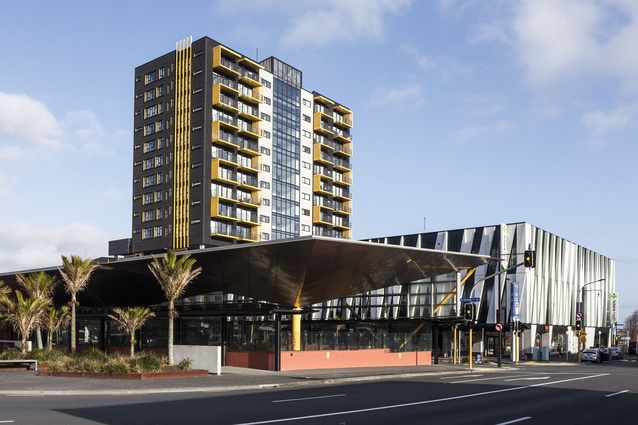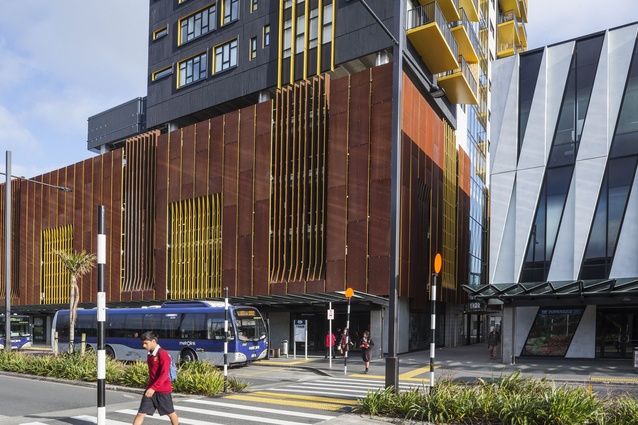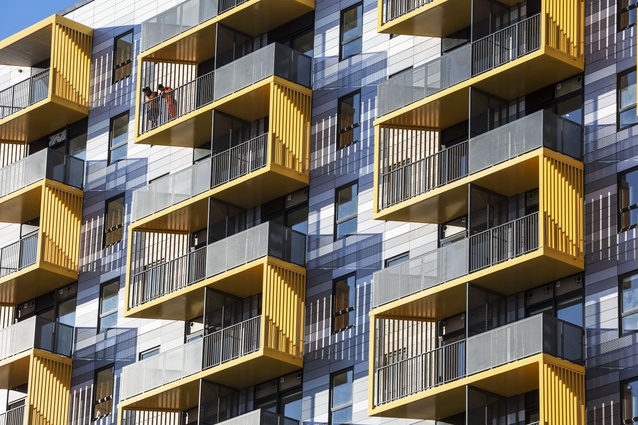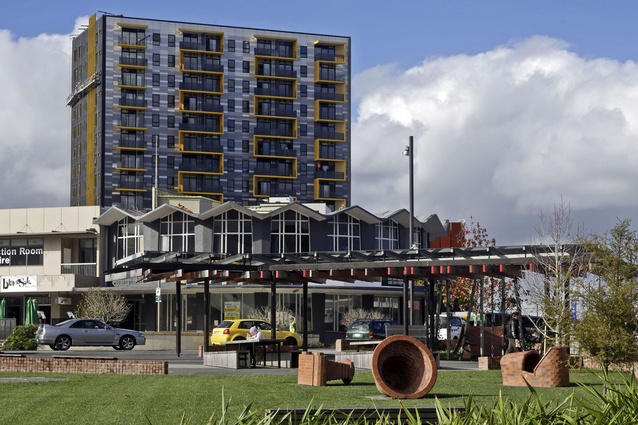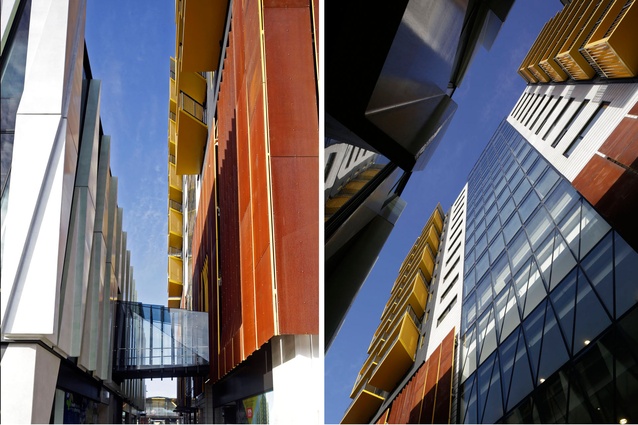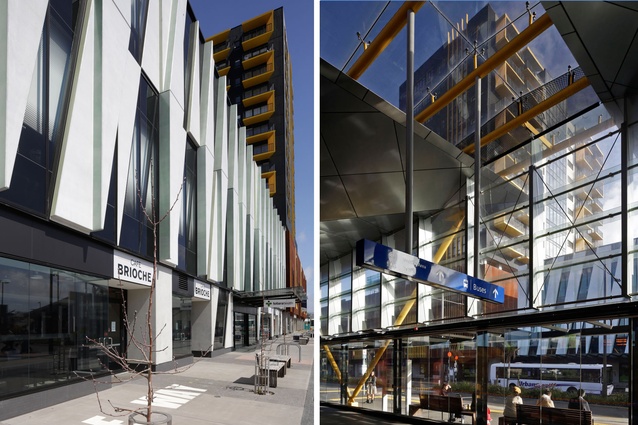Merchant Quarter
New Lynn is one of the more paradoxical Auckland suburbs: one of the oldest yet seeming newer than most. The country’s first mall, the massive ‘American-styled shopping centre’ Lynn Mall, landed here in 1963 and older Edwardian buildings, so prevalent elsewhere in Auckland, seem limited to a couple of dismal clusters further down the road. At least Lynn Mall was done up in the ’90s and has a few frilly bits of decoration to indicate the entrances; St Luke’s remains Auckland’s dumbest mall, so inadequate in its architectural language that it has a giant sign facing the car park declaring: “SHOPS HERE”.
New Lynn has its urban design challenges as well. Criss-crossed by traffic bypasses, and even a new flyover, it still seems to be a victim of the car with little in the way of pedestrian-friendly routes, pocket parks or pleasant little places in which to pause. It’s an ancient Ma-ori portage route but it seems as remote from the harbours as you can be on the Auckland isthmus. It’s home of the world-famous-in-New-Zealand Crown Lynn ceramics industry but you would need to do considerable detective work
to find any evidence of that.
I know people who have lived in New Lynn all their lives, rarely venturing into Auckland City, so the place has a small-town New Zealand feel to it: its own lawyers and accountants, suit-rental stores, funeral parlours, car yards, industry, fast-food strip and pornography precinct. But New Lynn has one thing much of Auckland hasn’t: a railway line. The train station by Architectus is one of the best I’ve seen and hopefully a harbinger of great things to come. The railway line has been double-tracked and trenched into the ground; previously, this line, while connecting New Lynn to Auckland, bisected and divided the local town centre. It seemed that, by burying the bellowing diesels, a more humane precinct would be created but it’s just allowed the torrent of Clark Street cars to encroach further. On the other side of the station is a great strip of bus stops. And it’s there we find the new Merchant Quarter.
Merchant Quarter is another stage in the redevelopment of New Lynn as one of Auckland’s metropolitan centres. It’s already the crossroads to the west and, with the massive investment in a public transport interchange, the aim is that a new generation of people will be able to afford cheap apartments here and either work in the area or commute into the city. Jasmax has designed two long buildings with a residential tower above. The north-eastern block is clad in a shard-like pattern of dark glass and light-coloured GRC; primarily, it houses a healthcare facility above shops and cafés. The south-western block, clad in weathering steel, holds nearly 300 car parks over more shops at street level. The tower is 10 storeys of apartments.
The whole of Merchant Quarter abuts both the transport interchange and the southern maw of Lynn Mall. In urban design terms, my first instinct as an apartment dweller is to look for outdoor space, both public and private, to mitigate cabin fever for those new to apartment living who also enjoy the Auckland climate. The northern side seems the favoured one for this. The long blocks form a buffer against both the buses and prevailing weather while a central laneway allows a direct shortcut to the train station. However, the shared space here and the war memorial forecourt to the Moller-designed library, while allowing a bit of sitting and people watching, don’t permit much in the way of a variety of spaces for lying on some grass, chucking a ball or escaping from the steady stream of pedestrians heading from cars to mall to McDonald’s and back. It is to be hoped that the next stage of the Council’s masterplan for the area, Merchant Square, will allow some provision for that.
Or perhaps it won’t; it is indicative that The National Business Review described the development of apartments here as “Hong-Kong style living”. Yes, there are numerous facilities nearby and, while they may seem to cover the spectrum from Les Mills’ exhortation to “unleash yourself” to a Lynn Mall retailer’s invitation to “indulge yourself”, one’s existence in an intensified environment needs to involve more nourishment for the human spirit than that provided by food alone or the promised cinemas of Phase Two. Around the corner, Totara Avenue has been made into a much more pleasantly scaled shared space, fringed with older buildings and allowing easier access to the New Lynn Community Centre, designed much earlier by Architectus and which has always seemed somewhat isolated. And the triangle of land adjacent to a couple of very fine modernist buildings has become a nice spot for a drink on the footpath and a literal breath of fresh air as an alternative to Lynn Mall’s air conditioning and artificiality.
In terms of urban design, it also needs to be seen whether the apartment tower will indeed be affordable and of a quality that will maintain one’s investment and place on the Auckland property ladder. And apartment complexes cannot be excused the duty to create a sense of neighbourhood. One would-be investor was alarmed to discover a column in a bedroom and the building doesn’t contain the kind of communal spaces that can both alleviate small apartment dimensions and promote a sense of neighbourliness, despite a developer referring to the residential tower as a “condominium” rather than an apartment block. It will be interesting to see who lives here; when even the Local Board Chair says, in language more akin to car purchase than home-ownership, “I would be there like a hungry dog. You’re getting it reasonably cheap and you can always flog it off later.” This indicates a rather crude understanding of community-making by both developer and Council. Affordable housing, even in the Auckland climate of crisis, needs to be about creation of community rather than just putting roofs over people’s heads. Otherwise, we are creating problems for ourselves later on.
In appearance, the buildings Jasmax has produced are certainly eye-catching. The GRC on one has been colour-matched to some classic Crown Lynn, we are told, and the weathering steel on the other relates to the car-manufacturing industry. The latter’s ventilation fins, apparently, are inspired by a 1969 Monaro. I find the residential tower as well to be about as subtle as is the blunt end of a bus with its bulldozer-yellow zig-zagging balconies. This seems to be a characteristic of contemporary apartment buildings: a LEGO-like fascination with façade-making and bright colours. When the future two-storeyed maisonettes are perched on top of the rust-coloured car-parking building, we run the risk that the whole assembly could resemble an aircraft carrier or container ship, stranded mid-portage between harbours.
Apartment and mixed-use buildings need to be heavily marketed: they are becoming more like objects, products or brands. The developer here describes the tower as “iconic, 50m in the sky in New Lynn”. For me, this formalism detracts from place-making and risks the future Auckland urban environment becoming a sea of stand-alone structures promoting their own identities. I support the intensification proposed in the Auckland Unitary Plan and the redevelopment of New Lynn at a new scale, but we need to remember that architecture also must use the subtleties of established architectural language to shape up various layers and types of private and public space for successful urban design.

